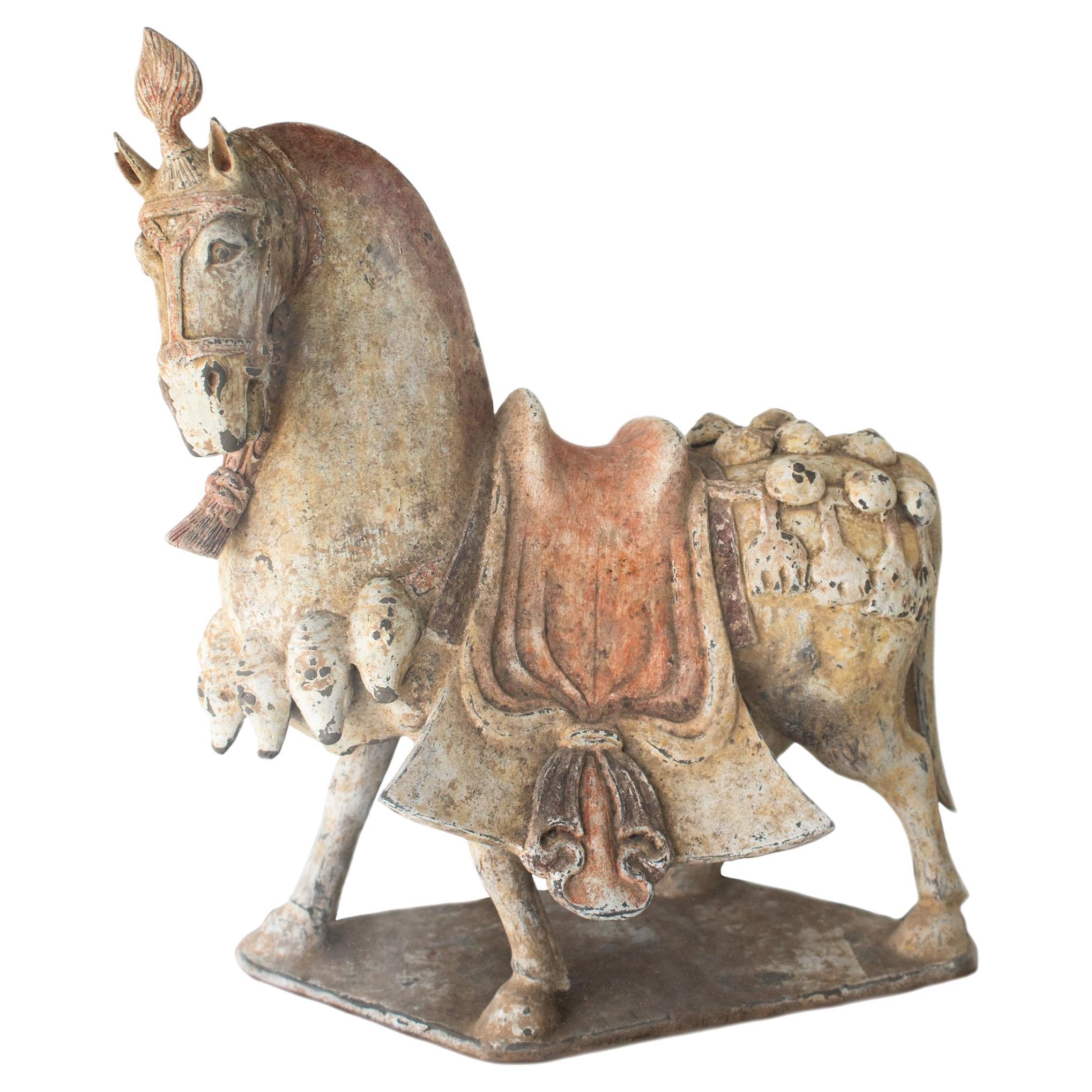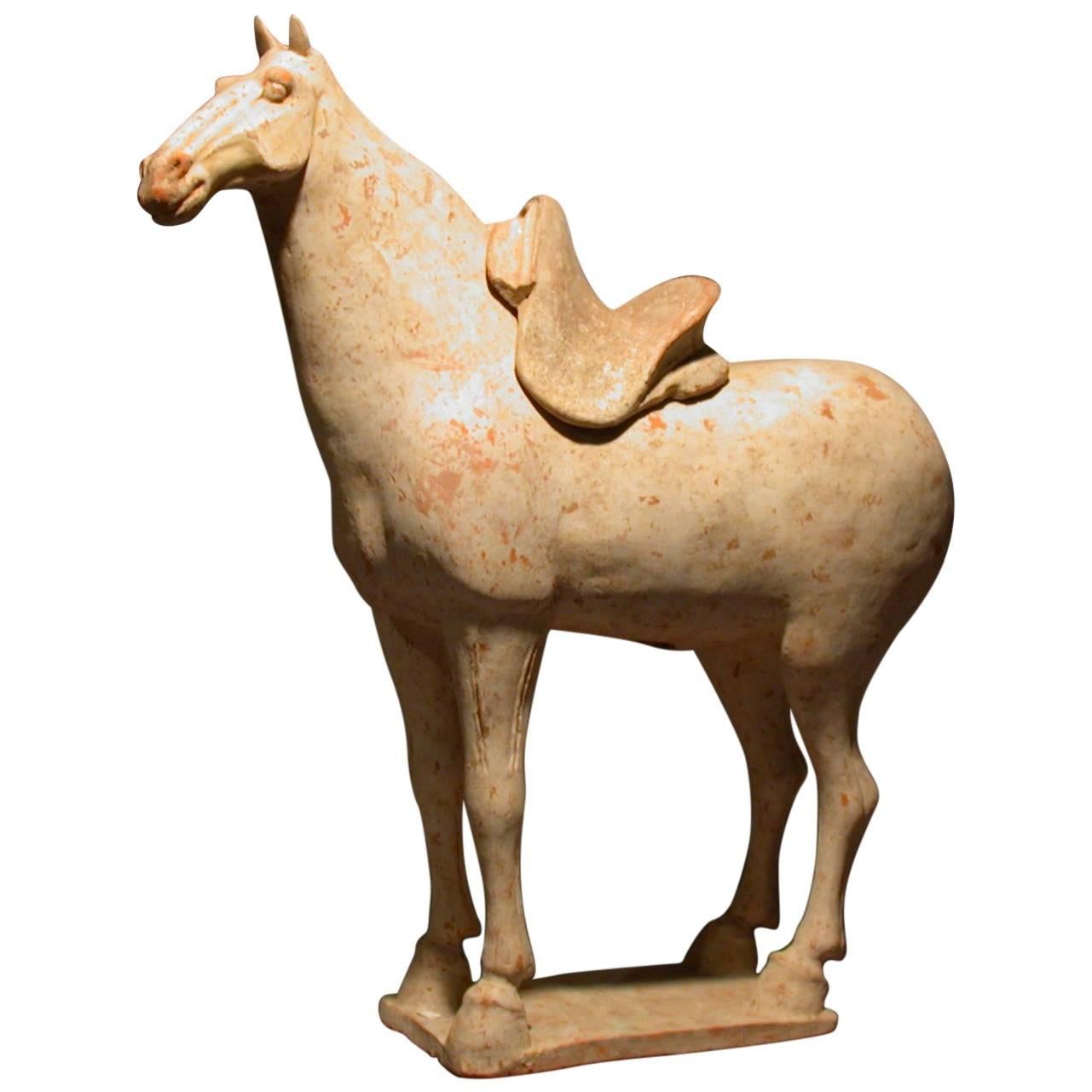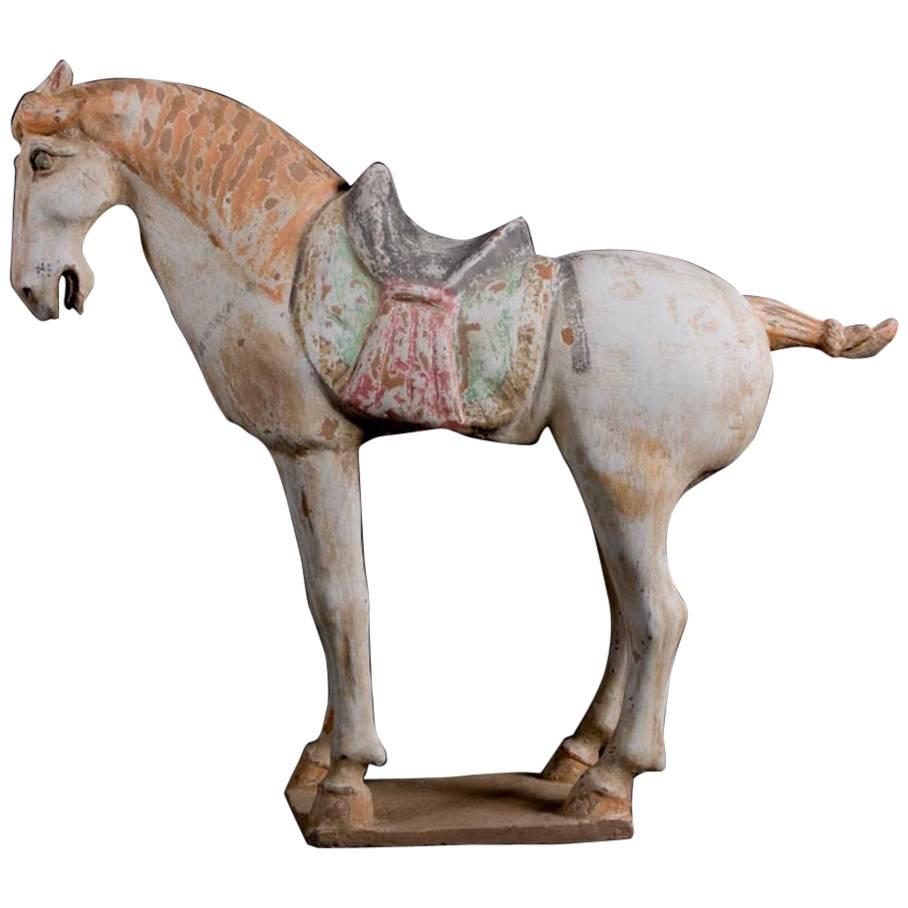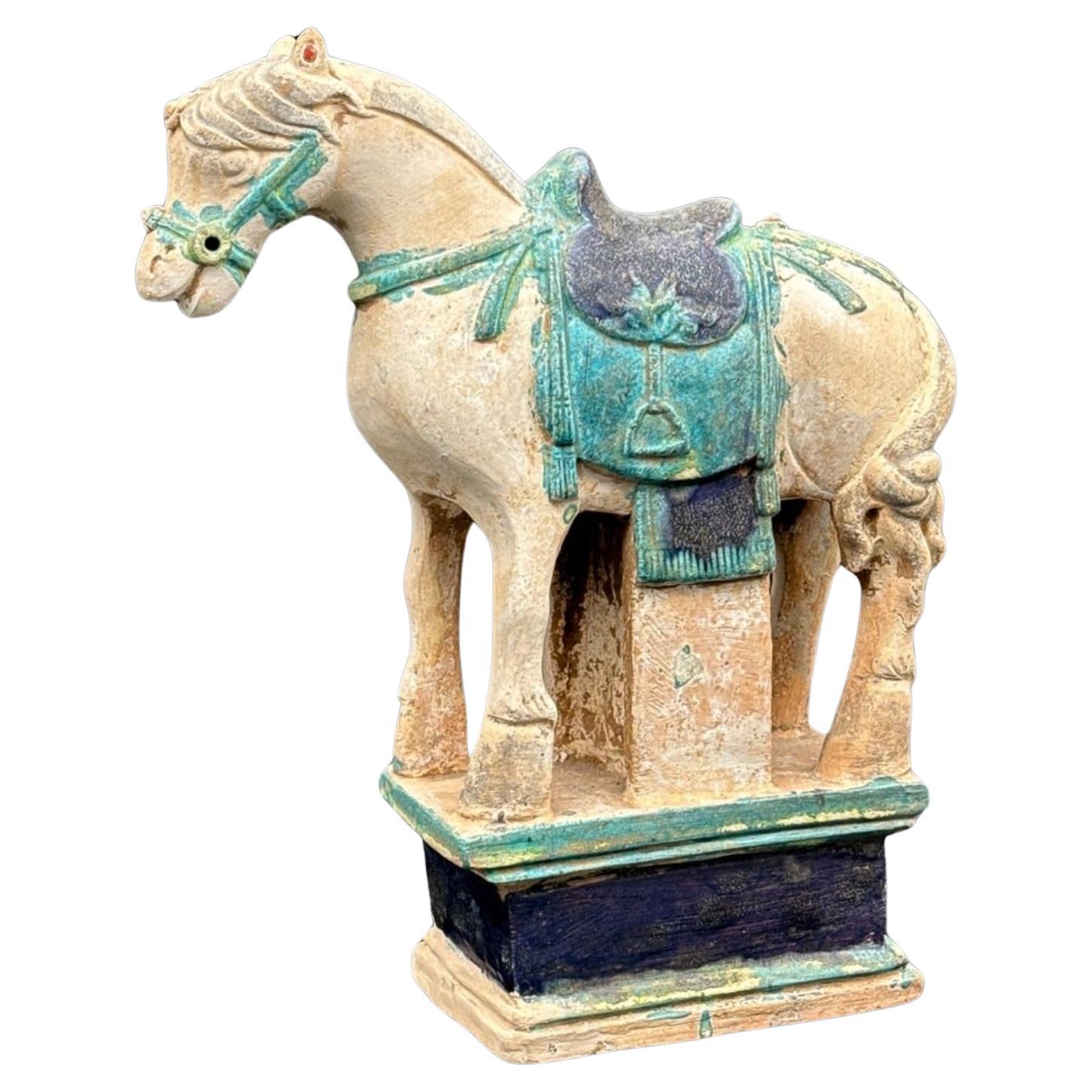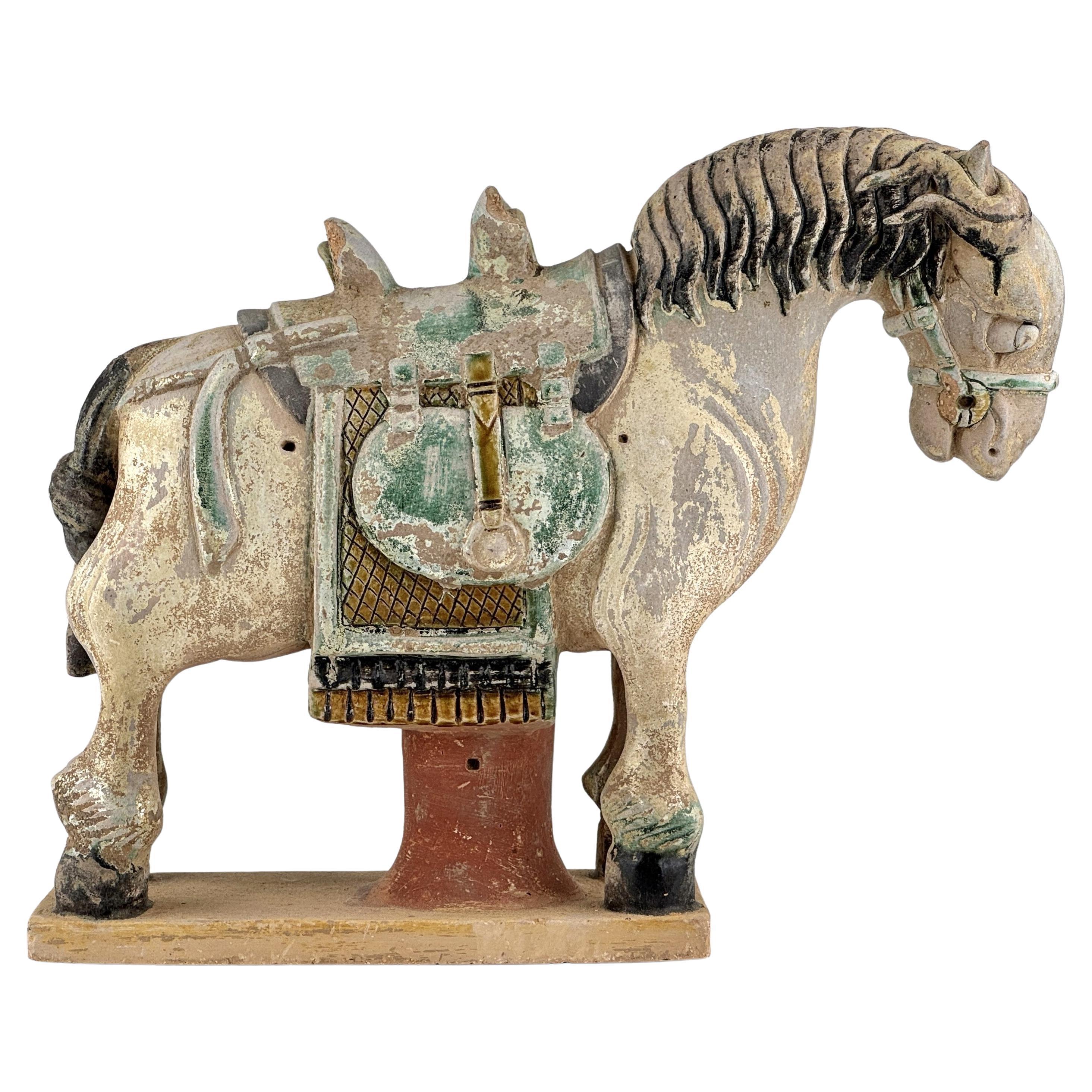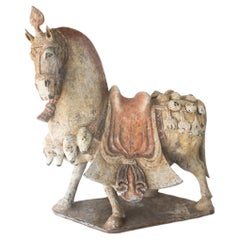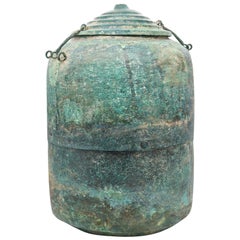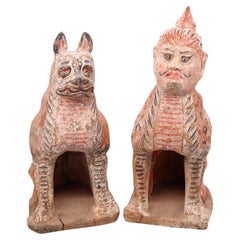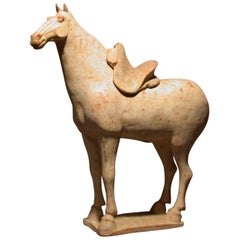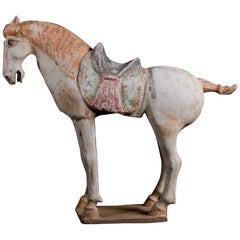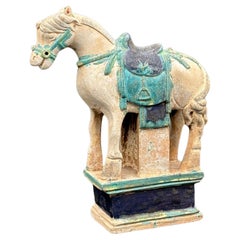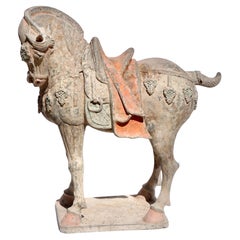Items Similar to China 549-577 AD Northern Qi Dynasty Ancient Caparisoned Horse in Earthenware
Want more images or videos?
Request additional images or videos from the seller
1 of 10
China 549-577 AD Northern Qi Dynasty Ancient Caparisoned Horse in Earthenware
$30,280
$37,85020% Off
£22,975.77
£28,719.7120% Off
€26,270.74
€32,838.4220% Off
CA$42,292.95
CA$52,866.1920% Off
A$47,024.01
A$58,780.0120% Off
CHF 24,553.34
CHF 30,691.6820% Off
MX$572,396.65
MX$715,495.8120% Off
NOK 313,289.94
NOK 391,612.4220% Off
SEK 293,537.70
SEK 366,922.1220% Off
DKK 196,063.33
DKK 245,079.1720% Off
Shipping
Retrieving quote...The 1stDibs Promise:
Authenticity Guarantee,
Money-Back Guarantee,
24-Hour Cancellation
About the Item
Extremely rare Chinese pottery caparisoned horse from the Northern Qi region.
A beautiful large sculptural piece, created in China during the Northern Qi dynasty period, between the 549 and 577 AD. This horse statue is extremely finely modeled of earthenware pottery, standing in a very elegant and majestic position striding on a trapezoidal shaped base.
The animal has a gracefully arched neck to the left looking forward and its extremely well modeled. The head is adorned with a large detailed tassels of plumes and the body is embellished with a beautiful saddle and intricate harnesses. The trapping around the chest and rump is adorned with elaborated tassels and the straps are accented with multiples florets and bosses in high relief. Decorated with dotted and circles patterns.
The surface is treated with applications of natural color pigments such; red, white and others.
Has a measurements of 435 mm by 319 mm by 243 mm (17.10 x 12.55 x 9.55 Inches) (43.5 x 31.9 x 24.3 Cm).
Northern Qi, was the successor state of the Chinese Xianbei state of Eastern Wei and was founded by Emperor Wenxuan. Emperor Wenxuan had a Han father Gao Huan (specially, he is a Xianbei in cultural conception), and a Xianbei mother, Lou Zhaojun. As Eastern Wei's powerful minister Gao Huan was succeeded by his sons Gao Cheng and Gao Yang, who took the throne from Emperor Xiaojing of Eastern Wei in 550 and established Northern Qi as Emperor Wenxuan. Northern Qi was the strongest state out of the three main states (the other two being Northern Zhou state and Chen Dynasty) in China when Chen was established. Northern Qi however was plagued by violence and/or incompetent emperors (in particular Houzhu), corrupt officials, and deteriorating armies. In 571, an important official who guide the emperors Emperor Wucheng and Houzhu, He Shikai, was killed. Houzhu attempted to strengthen the power of throne, instead he triggered a series of purges that became violent in late 573.
In 577, Northern Qi was assaulted by Northern Zhou, a northwestern kingdom with poorer resources. The Northern Qi, with ineffective leadership, quickly disintegrated within a month, with large scale defections of court and military personnel. Both Houzhu and the last emperor Youzhu were captured, and both died in late 577. Emperor Wenxuan son Gao Shaoyi, the Prince of Fanyang, under protection by Tujue, later declared himself the emperor of Northern Qi in exile, but was turned over by Tujue to Northern Zhou in 580 and exiled to modern Sichuan. It is a matter of dispute whether Gao Shaoyi should properly be considered a Northern Qi emperor, but in any case, the year 577 is generally considered by historians as the ending date for Northern Qi.
Provenance: China Gallery, Hong Kong, HK. Marc Richards Galleries Los Angeles, California. China Gallery New York city. Acquired in in October 22, 2007 New York city. In our personal collection.
Collateral: This sculpture is accompanied with a certificate for thermoluminescence analysis report (TL test), from the Oxford authentication Ltd, samples, No: C204C80. Signed by Doreen Stoneham. The three samples are consistent with the last firing period of 1000-1600 years ago.
Note: Three samples was taken in February 24 2005 by Carolyn Sickinger PH049/541. Under the head, at the firing hole and the buttock.
It is in perfect and impeccable condition, and the original pigmentation is lively.
INVENTORY REF: D0000RNNM/.1111.
- Dimensions:Height: 17.1 in (43.44 cm)Width: 12.55 in (31.88 cm)Depth: 9.44 in (23.98 cm)
- Style:Archaistic (Of the Period)
- Materials and Techniques:
- Place of Origin:
- Period:
- Date of Manufacture:549-577 AD
- Condition:Wear consistent with age and use. Three samples was taken in February 24 2005 by Carolyn Sickinger PH049/541. Under the head, at the firing hole and the buttock. It is in perfect and impeccable condition, and the original pigmentation is lively.
- Seller Location:Miami, FL
- Reference Number:Seller: D0000RNNM/.11111stDibs: LU8303233509472
About the Seller
5.0
Gold Seller
Premium sellers maintaining a 4.3+ rating and 24-hour response times
1stDibs seller since 2023
206 sales on 1stDibs
Typical response time: 4 hours
- ShippingRetrieving quote...Shipping from: Miami, FL
- Return Policy
Authenticity Guarantee
In the unlikely event there’s an issue with an item’s authenticity, contact us within 1 year for a full refund. DetailsMoney-Back Guarantee
If your item is not as described, is damaged in transit, or does not arrive, contact us within 7 days for a full refund. Details24-Hour Cancellation
You have a 24-hour grace period in which to reconsider your purchase, with no questions asked.Vetted Professional Sellers
Our world-class sellers must adhere to strict standards for service and quality, maintaining the integrity of our listings.Price-Match Guarantee
If you find that a seller listed the same item for a lower price elsewhere, we’ll match it.Trusted Global Delivery
Our best-in-class carrier network provides specialized shipping options worldwide, including custom delivery.More From This Seller
View AllChina 549-577 AD Northern Qi Dynasty Ancient Caparisoned Horse In Earthenware
Located in Miami, FL
Exceedingly rare Chinese pottery caparisoned horse from the Northern Qi region.
A beautiful sculptural piece, created in China during the Northern Qi dynasty period, between the 549 and 577 AD. This horse statue is extremely finely modeled of earthenware pottery, standing in a very elegant and majestic position striding on a trapezoidal shaped base.
The animal has a gracefully arched neck to the left and its extremely well modeled. The head is adorned with a large detailed tassels of plumes and the body is embellished with a beautiful saddle and intricate harnesses. The trapping around the chest and rump is adorned with elaborated tassels and the straps are accented with multiples florets and bosses in high relief.
The surface is treated with applications of natural pigments such; red, white and others.
Has a measurements of 394 mm by 343 mm by 257 mm (15.53 x 13.52 x 10.15 Inches) (39.4 x 34.3 x 25.7 Cm).
Northern Qi, was the successor state of the Chinese Xianbei state of Eastern Wei...
Category
Antique 15th Century and Earlier Chinese Archaistic Sculptures and Carvings
Materials
Earthenware, Pottery
$31,988 Sale Price
20% Off
China 960 Ad Song Dynasty Very Rare Imperial Period Offering Vessel in Bronze
Located in Miami, FL
Offering vessel from the Chinese Song Dynasty (960/1279 AD ).
A beautiful "offering spiritual vessel" from the Yunnan province region in the ancient China. This rare vessel was created in red bronze during the Song Dynasty period. between 960/1279 AD.
This is one of the most unusual forms of red bronze jar. A large vessel, the sides are virtually perpendicular to the base. The stepped lid design is also among the more rare types. The predominant lid design among the Yunnan offering bronzes is the "wheel" pattern, with a few lids having the lotus design. This is also one of the few bronzes displaying clear riveting of a two-part vessel body, with the original twisted elements
Has a combined measures including the lid of 12.5 by 8.75 inches (31.75 x 22,23 Cm).
The Song Dynasty, was an imperial dynasty of China that began in 960 and lasted until 1279. The dynasty was founded by Emperor Tizu of Song following his usurpation of the throne of the later Zhou, ending the Five-Dynasties and Ten Kingdoms period. The Song often came into conflict with the contemporaneous Liao, Western Xia and Jin dynasties in northern China. After decades of armed resistance defending southern China, it was eventually conquered by the Mongol-led Yuan dynasty.
The dynasty is divided into two periods: Northern Song and Southern Song...
Category
Antique 15th Century and Earlier Chinese Medieval Antiquities
Materials
Bronze
$3,960 Sale Price
20% Off
CERTIFIED 4, 531 Cts Colombian Emerald Sculptural Carving Of a Horse Figure
Located in Miami, FL
Standing horse figure carved from natural Colombian emerald.
This is a fabulous sculptural figure carved in one single piece of natural Colombian emerald, depicting a standing horse...
Category
Vintage 1970s Colombian Mid-Century Modern Figurative Sculptures
Materials
Multi-gemstone
China 618-907 AD Tang Dynasty Pair Of Polychromate Earth Spirits Zhenmushou
Located in Miami, FL
Pair of Earths Spirits "Zhenmushou" from the China Tang Dynasty 618-907 AD.
A beautiful and rare pair of "Earths Spirits guardians" from the Yunnan province region in the ancient China. This was created in clay earthenware pottery during the Tang Dynasty period between 618 and 907 AD. Featuring the molded figures of two seated guardians with decorations with polychrome pigmentations. The figures are seated on their haunches with cloven hooves planted firmly on the base looking forward with their front legs in a straight position. Both with face and body alert expressions on a rectangular base.
Earth spirits usually appear in pairs, one with a human head and the other with a lion head. Their supernatural powers, indicated by antlers, spiky flanges and flames, enable them to confront evil spirits and protect any precincts within their gaze. Have been believed to protect the living by keeping the spirits of the dead from inappropriately roaming the world outside the tomb.
Zhenmushou or guardian deities, developed from a line of protective spirits found normally in pairs at the front of Tang dynasty tombs. They served both to protect the figure from untoward spirits, and the outside world from the roving spirit of the dead. Combining features from a number of animals to form the perfect mythic beast, these mythical creatures were perceived to be the ideal guardians of the dead
The semi human faced figure has a measures of 11.25 by 4.5 by 5.75 inches (28.57 x 11.43 x 14.60 Cm).
The mythological lion animal figure has a measures of 10 by 5 by 5.8 inches (24.5 x 12.7 x 14.73 Cm).
Tang dynasty or Tang Empire, was an imperial dynasty of China that ruled from 618 to 907, with an interregnum between 690 and 705. It was preceded by the Sui dynasty and followed by the Five Dynasties and Tend Kingdoms period. Historians generally regard the Tang as a high point in Chinese civilization, and a the golden age of cosmopolitan culture. Tang territory, acquired through the military campaigns of its early rulers, rivaled that of the Han dynasty.
The Li family founded the dynasty, seizing power during the decline and collapse of the Sui Empire and inaugurating a period of progress and stability in the first half of the dynasty's rule. The dynasty was formally interrupted during 690–705 when Empress Wu Zetian seized the throne, proclaiming the Wu Zhou dynasty...
Category
Antique 15th Century and Earlier Chinese Tang Antiquities
Materials
Earthenware, Pottery
$4,600 Sale Price / set
20% Off
QING DYNASTY 1850 Sculptural Enthroned Mazu Quan-Yin In Solid Gilded Bronze
Located in Miami, FL
A 19th century enthroned Mazu Quan Ying from the Qing Dynasty.
This is a beautiful antique sculptural figure of an enthroned Mazu Quan Yin, cast in bronze in high relief in the late...
Category
Antique 1850s Chinese Qing Metalwork
Materials
Bronze, Gold
JAPAN 1900 Meiji Period Bronze Planter Vase With Carved Wood Base
Located in Miami, FL
Large Planter Vase from imperial Japan.
This a beautiful piece of Japanese decorative arts, created in Japan during the Meiji imperial period, circa 1900. The oversized vase can be ...
Category
Antique Early 1900s Japanese Meiji Metalwork
Materials
Bronze
You May Also Like
Fine Tang Dynasty Pottery Horse, Oxford TL Tested
Located in Greenwich, CT
Tang dynasty pottery statue of standing horse with removable saddle, Tang dynasty 618-907, come with Oxford authentication TL test certificate. Oxford test num...
Category
Antique 15th Century and Earlier Chinese Tang Sculptures and Carvings
Materials
Terracotta
Stunning Terracotta Standing Horse, Tang Dynasty, China '618-907 AD', TL Test
Located in San Pedro Garza Garcia, Nuevo Leon
Magnificent standing horse in orange terracotta and traces of painting. With a finely decorated saddle and with the mane and tail hair braided. TL Test by Ralph Kotalla Lab NE: 09K12...
Category
Antique 15th Century and Earlier Chinese Tang Antiquities
Materials
Terracotta
Antique Ming Dynasty Chinese Earthenware Horse Sculpture Míngqì Tomb Figure
Located in Forney, TX
A scarce 600 year old (approx) Chinese pottery Ming Dynasty (1368-1644) large glazed earthenware míngqì tomb figure, modeled as horse sculpture with saddle, stirrups, and integral ba...
Category
Antique 15th Century and Earlier Chinese Ming Sculptures and Carvings
Materials
Earthenware
Tang Dynasty Large And Important Pottery Horse TL Tested
Located in Dallas, TX
Large And Important Tang Dynasty (618-907AD) Pottery Horse TL Tested. China.
Ca. 618-907 AD A beautiful pottery figure of a horse. The animal is shown in a...
Category
Antique 15th Century and Earlier Tang Animal Sculptures
Materials
Pottery
Ming Period Large Pottery Horse with Saddle (15-16th Century)
Located in seoul, KR
The figure stands on a rectangular base. The horse is depicted in a poised stance, with strong, muscular legs and a slightly bowed head. The mane is carefully sculpted with deep, flowing grooves, adding a dynamic texture to the piece. The head features expressive details, including a well-defined muzzle, flared nostrils. The bridle and harness are delicately painted in faded green, contrasting against the creamy beige body. The saddle is adorned with intricate details, including decorative tassels and a textured pattern, indicative of the elaborate tack used in the Ming period.
Traces of original polychrome pigments in green, black, and ochre remain on the surface, hinting at the sculpture’s once-vibrant appearance. The weathered patina and areas of flaking paint add to its historical authenticity, reflecting centuries of age. The overall craftsmanship and detailing exemplify the Ming Dynasty’s refined ceramic artistry, making this piece a remarkable representation of of asian culture during this period.
Period: Ming Dynasty
Medium: Green, black, and ochre glazed Pottery
Type: Figure
Condition : Good(chips on the upper saddle.)
Provenance : Acquired in late 1990s from Hongkong
Reference : Asian Civilisations Museum - Accession No. C-1384 / 1994-00441 - Ming Dynasty Figure of Horse
(Type : Closely Related)
* Ming Dynasty Glazed Pottery Figures
Ming Dynasty glazed pottery figures are renowned for their bold color palette, intricate detailing, and lifelike forms, distinguishing them from earlier traditions. These figures, which depict officials, warriors, animals, and mythical creatures, are characterized by high-gloss lead-based glazes in green, amber, ochre, and sancai (three-color) combinations. The thickly applied glaze pools in recesses, creating depth and enhancing sculptural details. With dynamic postures, expressive facial features, and meticulously rendered drapery, these figures reflect the period’s advancement in ceramic craftsmanship, offering a greater sense of movement and realism compared to the rigid and stylized forms of earlier dynasties.
A defining characteristic of Ming glazed pottery is its elaborate surface detailing, often achieved through raised relief elements and contrasting glazes. Equestrian figures, for example, feature carefully sculpted saddles, harnesses, and decorative embellishments, while human figures are adorned with intricate robes and headdresses. The large scale of these tomb figures, often more imposing than those from previous periods, underscores the increasing importance of funerary art during the Ming era. Unlike later Qing Dynasty figures...
Category
Antique 15th Century and Earlier Hong Kong Ming Antiquities
Materials
Pottery
$2,800 Sale Price
30% Off
Ming Period Large Pottery Horse with Saddle (15-16th Century)
Located in seoul, KR
This Ming Dynasty painted pottery horse is depicted standing on a tiered rectangular pedestal. The horse has a well-proportioned body, with sturdy legs and a slightly arched neck. The eyes and muzzle are subtly outlined and incised.
The mane is sculpted with deep, parallel grooves. The tail is long and slightly curved left, extending downward. The saddle is prominently featured at the center of the horse’s back, detailed with a raised, rounded seat and an attached stirrup hanging down one side. The saddlecloth is textured with a crosshatch pattern, bordered by a row of carved fringe-like elements. The horse's legs display subtle musculature, and the hooves are clearly defined, with black pigment accentuating their edges.
The original painted pigments, including white, black, and ochre, are still visible, though faded in some areas. The black pigment highlights the mane, tail, and parts of the bridle, while the ochre tones accentuate the saddle and decorative elements.
Period: Ming Dynasty
Medium: Green, black, and ochre glazed Pottery
Type: Figure
Provenance : Acquired in late 1990s from Hongkong
Reference : Asian Civilisations Museum - Accession No. C-1384 / 1994-00441 - Ming Dynasty Figure of Horse
(Type : Closely Related)
* Ming Dynasty Glazed Pottery Figures
Ming Dynasty glazed pottery figures are renowned for their bold color palette, intricate detailing, and lifelike forms, distinguishing them from earlier traditions. These figures, which depict officials, warriors, animals, and mythical creatures, are characterized by high-gloss lead-based glazes in green, amber, ochre, and sancai (three-color) combinations. The thickly applied glaze pools in recesses, creating depth and enhancing sculptural details. With dynamic postures, expressive facial features, and meticulously rendered drapery, these figures reflect the period’s advancement in ceramic craftsmanship, offering a greater sense of movement and realism compared to the rigid and stylized forms of earlier dynasties.
A defining characteristic of Ming glazed pottery is its elaborate surface detailing, often achieved through raised relief elements and contrasting glazes. Equestrian figures, for example, feature carefully sculpted saddles, harnesses, and decorative embellishments, while human figures are adorned with intricate robes and headdresses. The large scale of these tomb figures, often more imposing than those from previous periods, underscores the increasing importance of funerary art during the Ming era. Unlike later Qing Dynasty figures...
Category
Antique 15th Century and Earlier Hong Kong Ming Antiquities
Materials
Pottery
$2,600 Sale Price
35% Off
